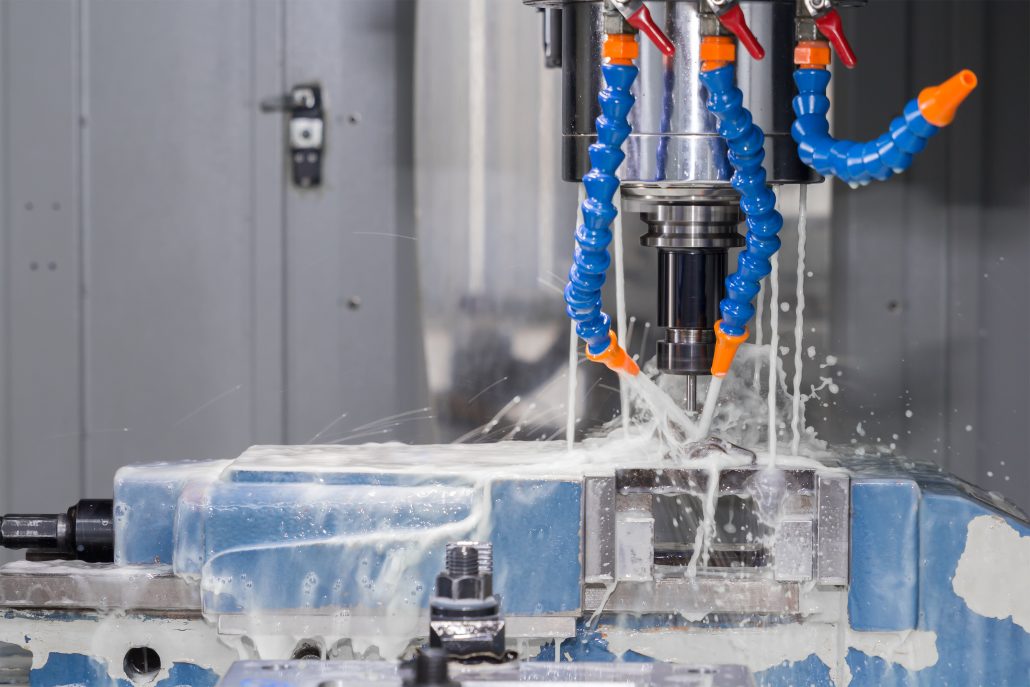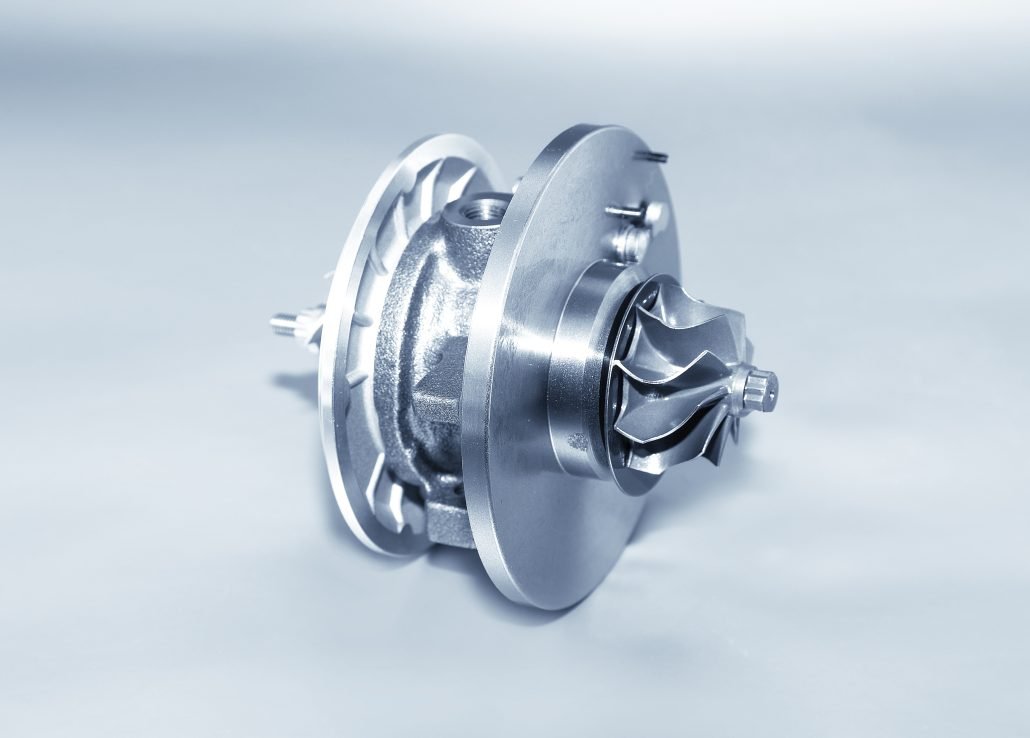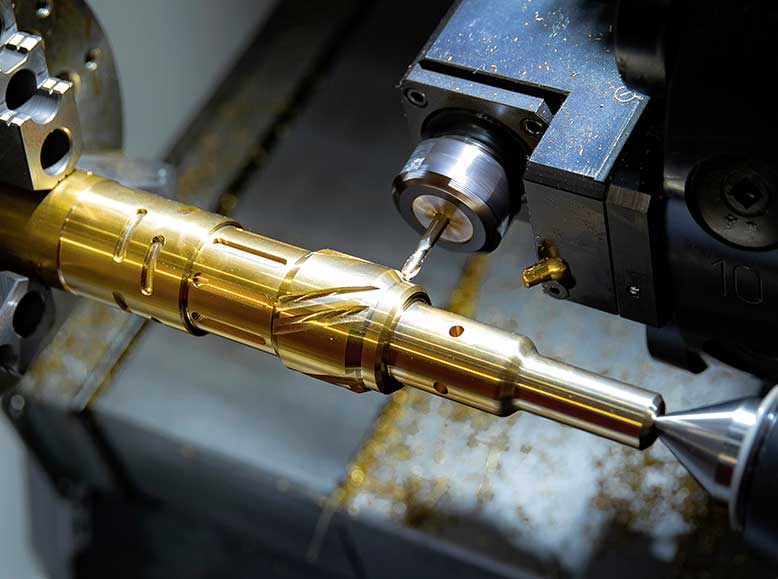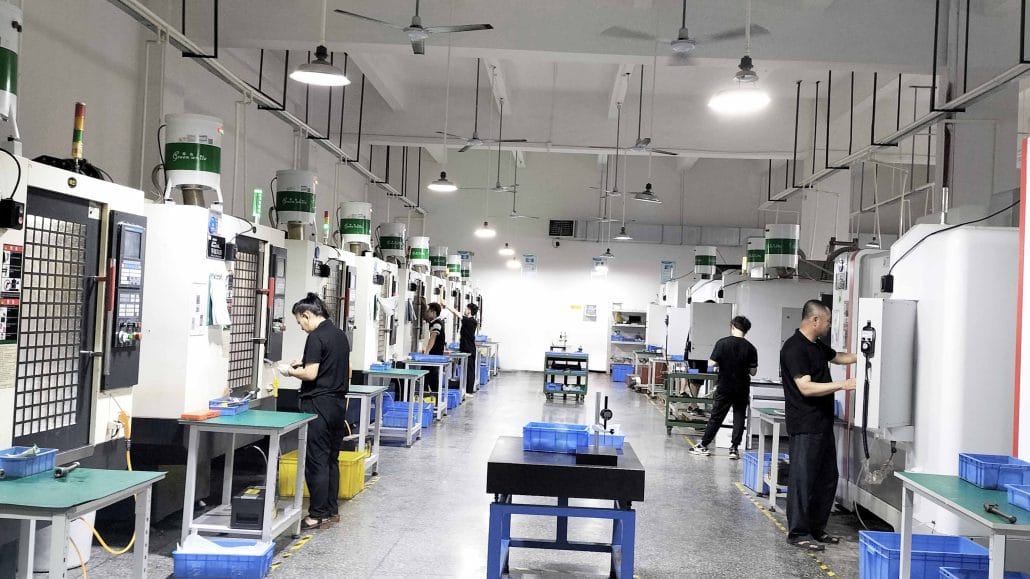In CNC machining, there are many types of CNC machines, among which the most representative are 4-axis CNC machines and 5-axis CNC machines. Therefore, 4-axis CNC machining and 5-axis CNC machining are the two most common mechanical machining methods in today’s manufacturing industry. When choosing a machining method, you need to consider the requirements of your product, the complexity of the machining process, and cost factors. This article will explain in detail what 4-axis CNC machining and 5-axis CNC machining are, the differences between them, and which one is suitable for your application. To help you make the right choice

Introduction to 4-axis CNC machining
4-axis CNC machining is based on 3-axis CNC, which increases the rotation axis of the machining machine to become a 4-axis and allows the machining components to rotate at any angle to obtain higher precision finished parts. These axes rotate around the x, y, and z axes, and one axis can rotate without changing the angle. This allows the cutting tool to enter the material at a certain angle. 4-axis CNC machining is very suitable for products that require contour and shape machining . They can handle complex shapes similar to engraving and surface machining. However, due to having only one axis of rotation, there are some limitations. A 4-axis machine can process cylinders, but it is not suitable for machining objects with complex shapes.
4-axis CNC machining process
Understanding the 4-axis CNC machining process requires attention to the movement and function of CNC machine tools. The following are the steps involved in the 4-axis CNC machining process:
Design parts: Use computer-aided design (CAD) software to create or import a 3D model of the parts you want to process. Ensure the accuracy of the model and take into account any limitations and requirements that may be encountered during the machining .
CAM programming: Use computer-aided manufacturing (CAM) software to convert the designed part model into a machining program that the machine can understand. CAM software generates tool paths, cutting parameters, and machining codes for controlling CNC machine tools.
Material preparation: Select appropriate materials and cut or trim as needed to obtain workpieces suitable for machining .
Clamping workpiece: Install the workpiece onto the workbench of the machine tool and use a fixture or fixture system to fix it, ensuring that the workpiece is stable and correctly positioned.
Tool preparation: Select appropriate tools according to machining requirements, and install and clamp them. Ensure that the tool is correctly installed and secured.
machining operation: Start the machining program by operating the CNC control panel or corresponding software interface. CNC machine tools control tool paths and cutting operations based on CAM generated machining codes. During the machining process, the tool will move on the X, Y, and Z axes according to program instructions and rotate on the rotation axis (fourth axis).
Inspection and quality control: After completing the machining, use measuring instruments such as micrometers, coordinate measuring machines, etc. to inspect the parts to ensure that the dimensions, shape, and surface quality meet the requirements.
The 4-axis CNC machining process may vary depending on different machine tools and machining requirements. Please refer to the specific machine tool operation manual and relevant safety operation guidelines to ensure correct and safe machining .
4-axis CNC machining type
The 4-axis CNC machining is divided into two types: simultaneous control of 4-axis and intermittent control of 4-axis. Different types are suitable for different machining needs
Simultaneous control
Simultaneous control of four axes refers to the simultaneous movement of all four axes. In synchronous control, all axes must operate at specific angles and speeds. This method is suitable for some machining steps, such as precision cutting or rotary machining of parts. This type of machining machine is suitable for the machining of complex parts, such as three-dimensional, curved, square, spiral and other shaped workpieces, which can improve machining efficiency and accuracy
Intermittent control
Intermittent control of 4-axis refers to controlling the time and angle of A-axis operation through a program. This method is suitable for some machining steps that require alternating operations, such as drilling holes, opening shells, precision machining, and deceleration motion. This type of machining machine is suitable for small batch and multi variety machining , such as machining special shaped parts such as conical, spherical, helical, and helical lines, improving production efficiency and economic benefits.

Introduction to 5-axis CNC machining
5-axis CNC machining is a mechanical machining method that adds a fifth rotating axis on top of 4-axis CNC machining. The fifth axis can rotate around other axes of the material at the same time, allowing the tool to enter and process the parts more flexibly. 5 axis CNC machining is commonly used to produce complex parts and workpieces, such as aircraft engine impellers and aerospace components. Based on CNC technology, it automatically controls the machining process and utilizes 5 axes to achieve multi-dimensional machining, including three-dimensional surfaces and very complex parts, with a manufacturing accuracy of up to 0.001 millimeters. Compared to the 4-axis CNC machining method, the 5-axis CNC machining has higher automation, accuracy, and efficiency.
5-axis CNC machining process
If you need to perform complex machining, 5-axis CNC machining can provide high-precision and fast solutions. Compared to 4-axis CNC machining, it has an additional inclined axis, allowing the tool to move on multiple angles and planes. The following are the steps involved in the 5-axis CNC machining process:
CAD design: Construct and design 3D models according to product requirements. Designers first need to perform sketch design, and then import the sketch into CAD software for model refinement and construction. The accuracy and quality of CAD design determine the complexity and efficiency of subsequent production processes.
CAM programming: Transforming the designed part model into a machining program that the machine can understand. CAM software generates tool paths, cutting parameters, and machining codes for controlling 5-axis CNC machine tools.
Machine tool settings: Adjust and set the machine tool, including clamping workpieces, installing machining tools, setting workpiece coordinates, selecting machining parameters, etc.
Real time monitoring and adjustment: During the machining process, use the real-time monitoring system or sensors of the machine tool to detect information such as the position, temperature, and cutting force of the cutting tool and workpiece. Based on this information, necessary adjustments and corrections can be made to ensure the accuracy and quality of the machining process.
Cutting cooling and lubrication: According to the machining materials and cutting conditions, use coolant or lubricants to cool and lubricate the cutting area to prevent tool overheating and surface quality issues of the workpiece.
machining inspection: machining inspection requires physical and chemical testing, including material hardness, size, flatness, roundness, and appearance. machining inspection requires testing and maintenance of the accuracy and precision of the inspection tools to ensure the reliability and accuracy of the inspection.
5-axis CNC machining type
There are three types of machining in 5-axis CNC machining technology: multi face machining, curved surface machining, and composite machining.
Surface machining
By using this technology, more complex geometric shapes can be manufactured on the surface of the part. Through the movement of the inclined and rotating axes, the tool can cut workpieces from multiple angles and planes, achieving complex shape machining. For example, car casings, aircraft airfoils, etc., it also includes three-dimensional carving, part contour machining , and surface finishing.
Composite machining
It can achieve machining between different materials and shapes. This machining technology is suitable for complex product manufacturing, such as composite material parts used in medical devices and aerospace equipment. In this type of machining, the 5-axis CNC machine tool will automatically identify different tools applied to each area and replace them at appropriate times.
Multi sided machining
5-axis multi face machining uses tools that rotate and swing on 5-axis CNC machines to process irregularly shaped parts. Compared with other machining types, multi sided machining only requires one clamping of the parts, saving production cycles and the cost of clamping the parts. In addition, the surface finish of multi sided machining is high, which can meet the manufacturing requirements of high-precision parts. Surface machining can be applied to different fields, such as manufacturing engines and engine parts in the aerospace industry, as well as automotive parts and mold manufacturing, such as general-purpose faucet molds.

The main difference between 4-axis machining and 5-axis CNC machining
First of all, we need to understand what 4-axis machining and 5-axis CNC machining are. Four-axis machining means that the machine tool can rotate around four axes in addition to the linear motion. 5-axis CNC machining means that the machining machine can be rotated on 5 axes, which allows for more complex machining and cutting. Now that 4-axis machining and 5-axis CNC machining are clear, let’s take a look at the main differences between them
The main difference between 4-axis machining and 5-axis CNC machining lies in the number of machine tool motion axes and machining capacity:
Number of axes:
Main axis of 4-axis cnc machining:
X axis: represents the horizontal movement of the machine tool, controlling the position of the workpiece in the horizontal direction.
Y axis: represents the vertical movement of the machine tool, controlling the position of the workpiece in the vertical direction.
Z axis: represents the longitudinal movement of the machine tool, controlling the position of the workpiece in the longitudinal direction.
Axis of rotation: Usually the axis of rotation of a table or spindle that controls the rotation of a workpiece or tool in a plane.
Main axis of 5-axis cnc machining:
X axis: represents the horizontal movement of the machine tool, controlling the position of the workpiece in the horizontal direction.
Y axis: represents the vertical movement of the machine tool, controlling the position of the workpiece in the vertical direction.
Z axis: represents the longitudinal movement of the machine tool, controlling the position of the workpiece in the longitudinal direction.
Axis A: Tilt axis, so that the tool can be tilted in the horizontal plane.
C axis: Axis of rotation that allows the tool to rotate in a vertical plane.
machining capacity
Under the same machining conditions, the machining accuracy of 5-axis CNC machining is higher than that of 4-axis CNC machining, because 5-axis CNC machining can eliminate machining errors by adjusting the Angle of parts in the machining process, so as to achieve more accurate machining operation. Here’s why:
4 axis CNC machining
A 4-axis machining machine tool is a basic CNC machine tool with four working axes, which are X (the horizontal axis moves forward and back), Y (the horizontal axis moves left and right), Z (the vertical axis moves up and down) and A (the axis of rotation).
The machining ability of 4-axis machine tool has certain limitations. It can only be processed in the horizontal plane, so for some complex shape of the workpiece, to complete the machining is required for multiple tool conversion, more complicated, low efficiency.
However, the advantage of 4 axis machining machine tool is that its economy is better, simple operation, convenient adjustment. At the same time, because its machining plane is fixed, so it will be more stable in machining .
5 axis CNC machining
Unlike 4-axis machine tools, 5-axis CNC machines have five axes, namely X, Y, Z and B, C. Compared with 4 axis machining machine, it has a wider range of machining capabilities.
5-axis CNC machining machine can rotate the machining plane without limit, and can be inclined machining, which makes the machining accuracy and efficiency have been improved. In the face of complex workpiece, 5-axis CNC machining machine can achieve a tool conversion, complete the whole machining process, thus greatly improving the machining efficiency and accuracy.
Obviously, in terms of machining capacity, 5-axis CNC machine tools are more advanced and efficient than 4-axis CNC machines. However, its price has also increased correspondingly, and the operation is complex, requiring professional skills to operate and adjust.
In addition to the 4-axis machining capability, 5-axis CNC machine tools can also tilt and rotate on two rotating axes, so as to achieve more complex surface machining, multi-angle machining and spiral machining.

Delivery time
4 axis machining allows parts to be processed on multiple planes at the same time. At the same time, 4-axis machining is very effective in producing a single product because most of the work can be done in one machining. However, 4-axis machining is less efficient when complex parts need to be produced.
In contrast, 5-axis CNC machining can be processed in all Spaces. Compared with 4 axis machining, it has greater flexibility and higher production efficiency. Although the initial cost of 5-axis CNC machining is relatively high, it offers higher production efficiency and accuracy in the production of complex parts.
4 axis machining and 5 axis CNC machining which is better
It depends on the specific machining needs and budget to determine which is better, 4-axis CNC machining or 5-axis CNC machining. Here’s how the two compare:
4 advantages of axis machining:
Lower cost: 4-axis machines are generally less expensive and easier to obtain and maintain than 5-axis machines.
Wide range of application: 4-axis machine tools are suitable for many common machining tasks, such as plane machining, contour machining and simple surface machining.
Surface finishing: 4-axis machining can carry out 3D engraving and machining on the machined surface to achieve precise detail machining and perfect surface treatment. It is also widely used to make molds, models and parts.
Simple operation and programming: Because only four axes of motion are involved, the operation and programming are relatively simple and the technical requirements are relatively low.
5 advantages of axis machining:
Higher machining capacity: The 5-axis machine tool has two rotating axes and is capable of more complex surface machining, multi-angle machining and spiral machining tasks.
Higher machining efficiency and accuracy: multi-axis control reduces the number of workpiece reclamping, improves the machining efficiency and accuracy, and reduces the machining error.
Stronger machining flexibility: the movement of tilt and rotation axis increases the machining flexibility, can adapt to more different angles and surface machining needs.
After looking at the advantages of the above two machining methods, which is better? It depends on your specific needs.
If you need to process simple workpieces quickly, then 4-axis CNC machining will suffice. It is more productive and more economical. At the same time, 4-axis CNC machining is generally more stable than 5-axis machining and therefore more suitable for mass production.
However, if you need to produce more complex work pieces, or need higher machining accuracy, then 5-axis CNC machining is more suitable. It has a wider range of machining , can be processed from different angles on the workpiece, can produce more precise parts. However, depending on different materials and machining parameters, 5-axis CNC machining usually requires longer machining time and higher cost.
However, it should be noted that 5-axis CNC machining usually takes longer to complete than 4-axis machining. Therefore, you need to take delivery time constraints into account when deciding which machining method to use.

Start your project with Longsheng CNC machining services
Whether you are developing new product prototypes, making parts or testing new designs, Longsheng Technology online CNC machining services can meet your needs. Our CNC machining center uses the most advanced equipment and technology in the industry to provide accurate and consistent production for your project.
We provide fully custom CNC machining services to meet the needs of all types and sizes of projects. Whether it is small or large, we can provide you with the best service. We have all the necessary tools and techniques to ensure that your project is processed in a timely and high quality manner.
Our machining equipment and technical team are ready to provide you with the best quality service. Don’t hesitate to contact us immediately to take full advantage of our machining techniques and professional options to start your next project
Conclusion
No matter which technology is selected, decisions should be made according to the specific situation to meet customer needs and product characteristics. In high-end manufacturing and parts machining , 5-axis CNC machining technology is the preferred technology. If your plant needs simple machining and assembly, but you don’t want to spend a lot of money on 5-axis CNC and so on, then choose 4-axis machining is enough.
FAQ
4-axis CNC machining is widely used in many industries, such as mold manufacturing, carving, woodworking, and so on. It is suitable for relatively simple parts and flat machining needs. 5-axis CNC machining is widely used in fields such as aerospace, automotive industry, medical equipment, etc., especially for parts with complex surfaces and workpieces that require high-precision machining.
4-axis CNC machining machine can only be processed in a plane, not three-dimensional machining . 5 axis CNC machining machine can be processed at any Angle, the workpiece is easier to process to every corner. Therefore, 5 axis CNC machining machine machining efficiency and machining quality are higher.


